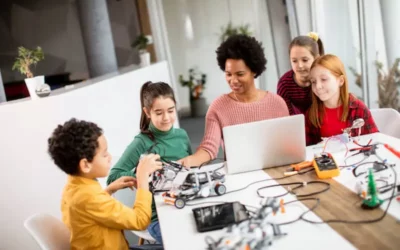Did you know that some of the characters in your kids’ favorite cartoons are brought to life with the help of artificial intelligence? From creating lifelike animation basics to helping solve complex problems, AI is like a magical tool that’s making our world smarter and more exciting every day.
As parents, you want the best for your children’s education, and that’s where the fascinating world of Artificial Intelligence steps in. In this article, we’ll journey through the remarkable ways AI is transforming education, making it more personalized, engaging, and effective. So, let’s dive in!
Table of contents
- Introduction to Artificial Intelligence in Education
- The Current Landscape of K-12 Education
- AI and Machine Learning Fundamentals
- Transforming K-12 Education through AI
- Future of K-12 Curriculum: Integrating AI
- AI in the Classroom: Enriching Learning Experiences
- AI in K-12 Assessment and Evaluation
- Smart Technology in Schools: Creating AI-Enabled Environments
- Fostering Creativity and Critical Thinking with AI
- Conclusion
Introduction to Artificial Intelligence in Education
Artificial Intelligence, or AI, is like having a super-smart companion that learns and understands just like humans. It’s the technology that enables Computer components to think and act like humans, which opens up endless possibilities for enhancing education. AI-powered tools can analyze data, make predictions, and even adapt to individual learning needs. In essence, AI acts as a virtual learning assistant, customizing education for each child’s unique style.
Significance of Integrating AI into the Education Sector
As parents, you’re well aware of the traditional teaching methods that can sometimes feel one-size-fits-all. This is where AI shines. It’s not about replacing teachers, but about complementing their efforts. AI for kids can create tailored learning paths, assesses progress, and offer immediate feedback, making the learning experience much more effective and enjoyable. This technology ensures that your child’s education isn’t just limited to the classroom; it’s a dynamic, personalized journey.
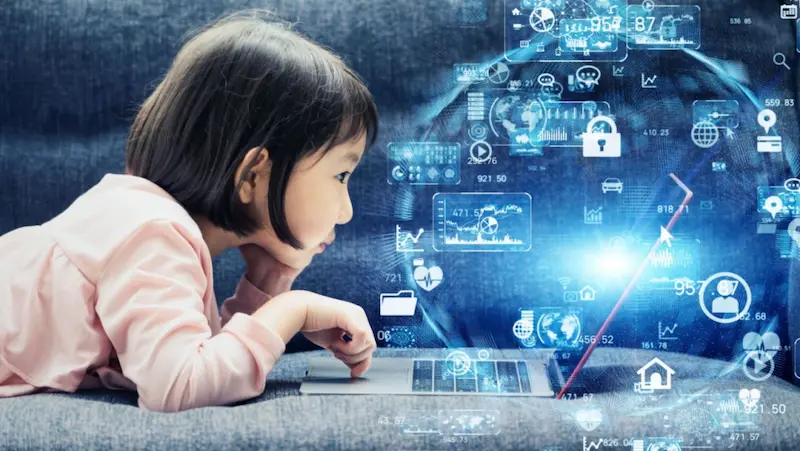
The Current Landscape of K-12 Education
A. Traditional Approaches to Teaching and Learning
The familiar classroom setup might evoke memories of chalkboards and textbooks, but education is evolving. However, traditional methods can fall short in catering to individual learning needs and keeping students engaged.
B. Challenges Faced by the K-12 Education Sector
Educators often grapple with crowded classrooms, varying learning paces, and limited resources. Students might struggle to grasp certain concepts or get bored with standardized lessons. These challenges highlight the need for innovative solutions that AI can provide.
C. Need for Innovation in Educational Methods
Innovation is key to addressing these challenges. The education landscape is ripe for change, and AI offers the opportunity to revolutionize the way we teach and learn. It’s about embracing technology to create an environment where every child thrives.

AI and Machine Learning Fundamentals
A. Understanding AI and Machine Learning Concepts
Imagine if your child’s educational tools could learn and adapt to their progress, just like a personal tutor. This is where machine learning, a subset of AI, comes into play. Machine learning algorithms can identify patterns in data and use these insights to improve over time.
B. Applications of AI and Machine Learning Beyond Education
AI isn’t limited to the classroom; it’s all around us. From voice assistants to recommendation systems on streaming platforms, AI is already part of our daily lives.
C. Potential Benefits of AI-Driven Learning Experiences
AI can transform education by providing tailored learning experiences, identifying areas where students struggle, and adapting content accordingly. This approach not only enhances understanding but also boosts confidence and motivation.
Transforming K-12 Education through AI
A. Personalized Learning Paths with AI
Every child has a unique learning pace and style. AI can create personalized learning paths that adapt to individual strengths and challenges, ensuring that no one falls behind or gets left unchallenged.
B. Adaptive Assessment and Feedback Systems
Gone are the days of waiting for test scores. AI can provide instant feedback on assignments and assessments, helping students understand their mistakes and improve faster.
C. Enhancing Teacher Efficiency with AI-Powered Tools
Teachers play a pivotal role, and AI tools can alleviate their administrative burden, allowing them to focus more on teaching and nurturing young minds.
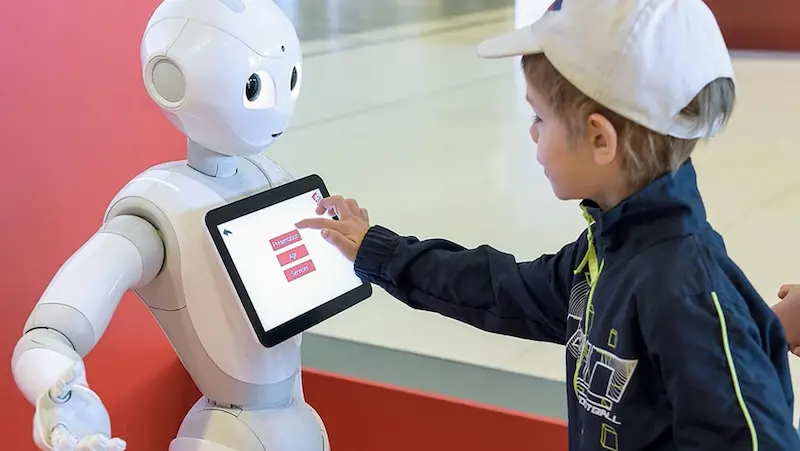
Future of K-12 Curriculum: Integrating AI
Imagine if your lessons were like puzzles designed just for you! AI helps teachers create personalized learning paths that match your interests and strengths, making each day at school an exciting adventure.
Have you ever wondered how your textbooks are made? With AI, educational content is like a magical storybook that changes to fit your learning style, making sure you understand everything easily.
Just like superheroes have rules, AI also has ethical guidelines. Schools make sure AI is fair, respectful, and kind, so that everyone gets a chance to learn and grow.
AI in the Classroom: Enriching Learning Experiences
- Virtual and Augmented Reality for Immersive Learning With AI-powered virtual and augmented reality, classrooms transform into portals of exploration. Imagine walking through ancient civilizations, exploring the deepest oceans, or even journeying into space – all within the four walls of your classroom. Visual and interactive experiences captivate students, making learning engaging, memorable, and expanding their horizons beyond textbooks.
- Gamification and Interactive Simulations AI brings an element of fun into learning through gamification. Lessons become like exciting quests, where students tackle challenges, earn rewards, and progress through levels as they master concepts. Interactive simulations, powered by AI, provide a safe space for experimentation and problem-solving, enabling students to grasp complex topics through hands-on exploration.
- Natural Language Processing for Language Learning Learning a new language becomes more interactive and dynamic with AI-driven natural language processing. AI analyzes speech patterns, offers real-time corrections, and engages in conversations, allowing students to practice and improve their language skills with a virtual language partner. This personalized approach enhances pronunciation, comprehension, and confidence in communicating effectively.
- Adaptive Learning Pathways AI tailors learning journeys based on individual strengths, weaknesses, and learning preferences. By analyzing a student’s progress and performance, AI adapts the curriculum to suit their pace and style. This ensures that each student receives a customized learning experience, reducing frustration and boosting motivation as they see continuous improvement.
- Real-Time Feedback and Support AI provides instant feedback, mimicking the presence of a teacher even outside school hours. Whether solving math problems, composing essays, or practicing coding for kids, AI identifies errors and offers explanations. This constant support encourages independent learning, fostering a sense of achievement and self-assurance among students.
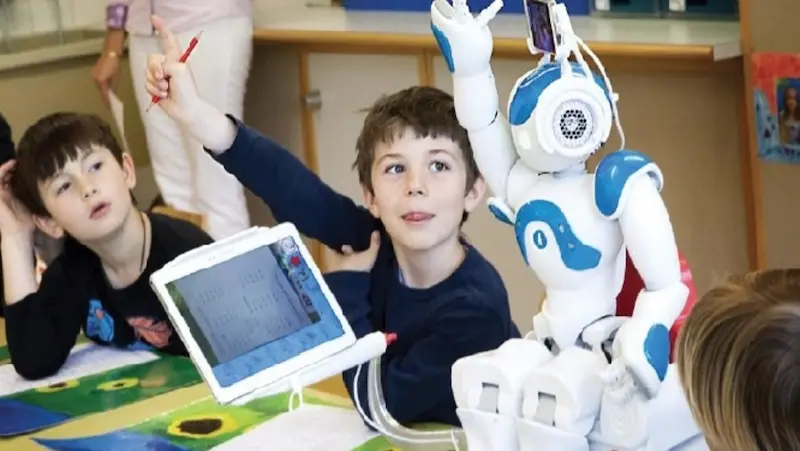
AI in K-12 Assessment and Evaluation
- Automated Grading and Performance Analysis AI takes on the role of the time-consuming task of grading assignments and assessments. It swiftly evaluates multiple-choice questions, short answers, and even complex problems. This speeds up the feedback process, allowing teachers to focus on providing personalized guidance and support to students.
- Real-Time Student Progress Tracking AI enables educators and parents to monitor student progress in real time. Through data analysis, AI generates detailed reports highlighting strengths and areas needing improvement. This timely feedback guides targeted interventions, ensuring students receive the support they need to succeed.
- Redefining Standardized Testing with AI Standardized tests undergo a transformation with AI. Instead of traditional pen-and-paper assessments, AI-driven tests adapt to each student’s performance level, presenting questions of appropriate difficulty. This dynamic approach ensures that assessments accurately reflect a student’s understanding and growth, making testing less stressful and more meaningful.
- Personalized Learning Pathways AI utilizes assessment data to create personalized learning pathways. By understanding each student’s proficiency in different subjects, AI tailors content and assignments to match their skill level. This personalized approach fosters a deeper understanding of concepts and encourages a love for learning.
- Identifying Learning Patterns and Trends AI’s analytical capabilities allow educators to identify patterns and trends in student performance. By recognizing recurring challenges, educators can adjust teaching strategies and materials to address specific learning gaps. This proactive approach ensures that students receive targeted support to overcome hurdles.
Smart Technology in Schools: Creating AI-Enabled Environments
Imagine classrooms that know what you need before you even ask! AI helps create super-smart classrooms that make learning comfortable and exciting.
AI uses special devices to collect information and create reports that help teachers understand how to help you learn better. Just like you protect your secret treasures, schools and AI experts work together to keep your information safe and sound.
Fostering Creativity and Critical Thinking with AI
A. AI as a Tool for Cultivating Creative Skills: AI is like an artist’s paintbrush that helps you create amazing things. It encourages you to think outside the box and dream big dreams.
B. Encouraging Problem-Solving and Analytical Thinking: Puzzles and challenges are like brain workouts. AI gives you lots of exciting problems to solve, making your brain strong and ready for anything.
C. Collaborative Learning in AI-Driven Environments: Ever Build Gaming PC a sandcastle with friends? AI helps you work together on projects, so you learn how to share ideas and create something incredible as a team.
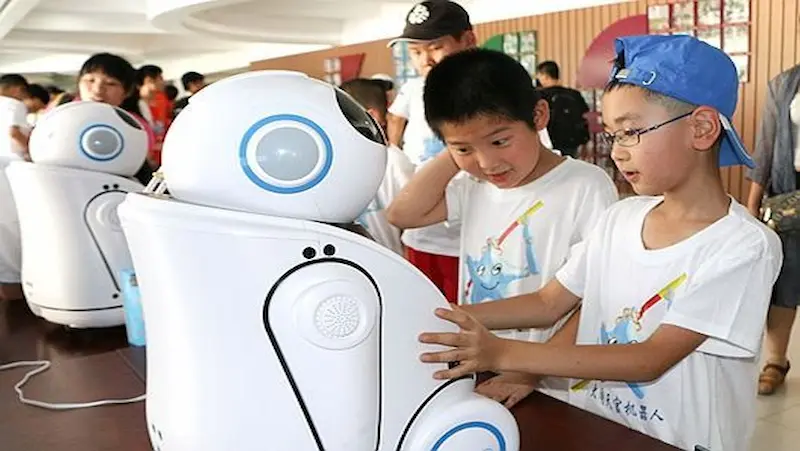
Conclusion
As we conclude this fascinating journey through the world of Artificial Intelligence Education, one thing is abundantly clear: the future of learning is brighter and more exciting than ever before. AI isn’t just a magical friend in video games for kids; it’s a guiding light in our classrooms, empowering educators, and nurturing curious minds.
The integration of AI into the K-12 curriculum is not a replacement for human connection but a harmonious blend that fuels creativity, personalization, and inclusivity. With virtual reality adventures, AI-driven challenges, and personalized learning paths, education becomes a captivating odyssey, inviting students to explore, question, and innovate.
As we embrace this AI revolution, let us remember that the heart of education remains human, even as technology paints new possibilities on the canvas of tomorrow’s world.
Navigating the complex landscape of education and child development can be daunting, but with the BrightChamps blog page at your fingertips, you’ll find clarity and confidence in your journey. Check out BrightCHAMPS, To get your hands on more such educational and free resources on coding, robotics courses for kids, game development, etc.
To get your hands on more educational and free resources on coding for kids, robotics for kids, financial education for kids, etc., do check out the BrightCHAMPS Page now!
Frequently Asked Questions
A1. Artificial Intelligence in education refers to the integration of advanced technologies that enable machines to mimic human-like intelligence, enhancing teaching and learning processes through personalized experiences and data analysis.
A2. AI enriches learning by tailoring content to individual needs, offering immersive experiences through virtual reality, gamification, and language processing, fostering creativity, and providing real-time progress tracking for personalized support.
A3. Implementing AI faces challenges like privacy concerns, lack of educator training, potential bias in algorithms, and adapting to rapid technological changes while maintaining a balanced human touch in education.
A4. Educators can prepare by embracing AI tools, participating in training programs, nurturing critical thinking and problem-solving skills, and emphasizing ethical considerations while integrating technology to enhance student learning and engagement.


 We are an army of educators and passionate learners from BrightChamps family, committed to providing free learning resources to kids, parents & students.
We are an army of educators and passionate learners from BrightChamps family, committed to providing free learning resources to kids, parents & students.




